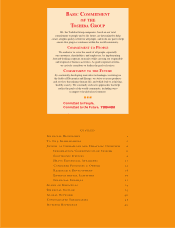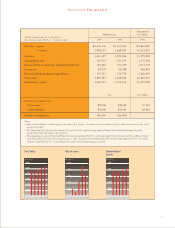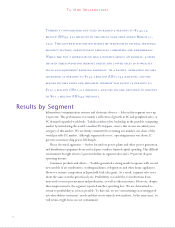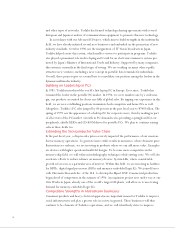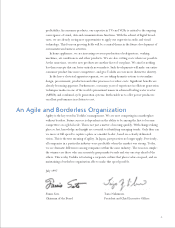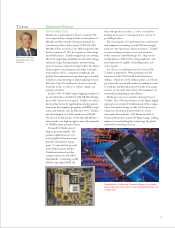Toshiba 1997 Annual Report Download - page 12
Download and view the complete annual report
Please find page 12 of the 1997 Toshiba annual report below. You can navigate through the pages in the report by either clicking on the pages listed below, or by using the keyword search tool below to find specific information within the annual report.
10.
Toshiba completed construction of its new
Advanced Microelectronics Center in Yokohama
in April 1996. This facility will concentrate on
research in the ultra-LSI devices required in this age
of gigabit-class memory chips and rapid advances in
system LSIs.
In May 1996, a second
clean room was com-
pleted at the Yokkaichi
Works, Toshiba’s
primary production base
for semiconductor
memories. Yokkaichi
and a plant now under
construction in the U.S.
by Dominion Semicon-
ductor, L.L.C., a joint
venture of Toshiba and
IBM, will be the primary
suppliers of DRAMs.
Production of system LSIs is the responsibility of
Toshiba’s Oita Works. To keep ahead of meteoric
growth in demand, Toshiba is converting this facility
into one of the world’s largest system LSI plants.
Plans call for the incorporation of 0.25-micron-rule
technology as well as the leading-edge multilayer
processes needed to manufacture MPUs.
Liquid Crystal Displays
Markets for LCDs staged a dramatic improvement
during the past fiscal year as demand for notebook
PCs surged. Toshiba was a major beneficiary,
leveraging expertise in the development of next-
generation LCDs, which have large screens and
highly efficient operation, to achieve a substantial
increase in sales.
Display Technologies, Inc., another joint venture
with IBM, began full-scale production on the phase-
3 line at its Yasu Plant in June 1996. This new line is
the world’s first commercial-scale facility capable of
using glass substrates large
enough for six 12.1-inch
screens. By using these
substrates, this line raises
productivity to about three
times more than the
company’s phase-2 line.
For desktop computers,
Toshiba developed a slender
15-inch LCD module that has
high-resolution and a screen
size comparable to that of a
17-inch CRT monitor.
Another achievement was the use of the low-
temperature polysilicon method in a 12.1-inch
model for the first time ever. Preparations for mass
production at a Toshiba plant will begin in the fall
of 1997, well ahead of competitors. Polysilicon is
expected to account for a rising share of LCDs as the
shift from amorphous silicon designs accelerates.
One advantage is a dramatic reduction in wiring
points since polysilicon enables the placement of the
driver circuitry function within the display panel.
This contributes to higher reliability while enabling
a slimmer and lighter construction than in current
amorphous models.
Other Electron Devices
Sales of TV color picture tubes increased. This was
primarily the result of higher sales of 4:3 large-
screen models in China, which more than offset
weakness in wide-screen tubes in Japan.
Continuing growth in the global PC market led
to higher sales of color display tubes for computer
monitors. Large-screen monitors are accounting for
a rising share of industry-wide sales. Having initiated
full-scale production of 17-inch MICROFILTER™
display tubes, Toshiba is well positioned to benefit
from this trend. This exclusive Toshiba technology
yields a significant improvement in contrast.
Preparations have begun for the start-up of 19-inch
models as well.
Toshiba continues to make investments to expand
in step with global demand for rechargeable batter-
ies, both lithium-ion and nickel-metal-hydride. Sales
of lithium-ion rechargeable batteries are projected
to rise at an annual rate of more than 20 percent for
the next several years. Toshiba added to its line-up
of prismatic batteries by introducing two cylindrical
models for notebook PCs.
Targeting a new market
with immense potential,
Toshiba has developed a
15-inch LCD for desktop
PCs. Commercial produc-
tion of these displays started
in June 1997.
Long one of the world’s leading makers of
lithium-ion rechargeable batteries, Toshiba is
expanding its lineup of these rechargeable power
supplies for notebook PCs.
With the completion of a
second state-of-the-art
clean room at its Yokkaichi
Works, Toshiba has the
capability to produce 64M
DRAMs as well as 256M
DRAMs in the future.


